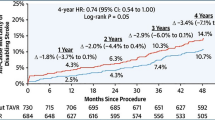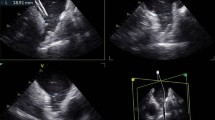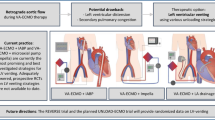Abstract
With the ongoing shortage of available organs for heart transplantation, mechanical circulatory support devices have been increasingly utilized for managing acute and chronic heart failure that is refractory to medical therapy. In particular, the introduction of the left ventricular assist devices (LVAD) has revolutionized the field. In this review, we will discuss a brief history of the LVAD, available devices, current indications, patient selection, complications, and outcomes. In addition, we will discuss recent outcomes and advancements in the field of noncardiac surgery in the LVAD patient. Finally, we will discuss several topics for surgical consideration during LVAD implantation.
Similar content being viewed by others
References
Kirklin JK, Naftel DC, Pagani FD, Kormos RL, Stevenson LW, Blume ED, et al. Seventh INTERMACS annual report: 15,000 patients and counting. J Heart Lung Transplant. 2015;34(12):1495–504.
Lund LH, Edwards LB, Kucheryavaya AY, Benden C, Dipchand AI, Goldfarb S, et al. The Registry of the International Society for Heart and Lung Transplantation: thirty-second official adult heart transplantation report—2015; focus theme: early graft failure. J Heart Lung Transplant. 2015;34(10):1244–54.
Rose EA, Gelijns AC, Moskowitz AJ, Heitjan DF, Stevenson LW, Dembitsky W, et al. Long-term use of a left ventricular assist device for end-stage heart failure. N Engl J Med. 2001;345(20):1435–43.
DeBakey ME. Left ventricular bypass pump for cardiac assistance. Am J Cardiol. 1971;27(1):3–11.
Norman JC. ALVAD 1979: precedence, potentials, prospects and problems. Cardiovasc Dis. 1979;6(4):384–9.
Rector TS, Taylor BC, Greer N, Rutks I, Wilt TJ. Use of left ventricular assist devices as destination therapy in end-stage congestive heart failure: a systemic review. 2012 [cited 2015 Dec 24]. http://www.ncbi.nlm.nih.gov/books/NBK99056/.
Slaughter MS, Rogers JG, Milano CA, Russell SD, Conte JV, Feldman D, et al. Advanced heart failure treated with continuous-flow left ventricular assist device. N Engl J Med. 2009;361(23):2241–51.
Slaughter MS, Pagani FD, McGee EC, Birks EJ, Cotts WG, Gregoric I, et al. HeartWare ventricular assist system for bridge to transplant: combined results of the bridge to transplant and continued access protocol trial. J Heart Lung Transplant Off Publ Int Soc Heart Transplant. 2013;32(7):675–83.
Kitada S, Schulze PC, Jin Z, Clerkin KJ, Homma S, Mancini DM. Comparison of early versus delayed timing of left ventricular assist device implantation as a bridge-to-transplantation: an analysis of the UNOS dataset. Int J Cardiol. 2016;15(203):929–35.
Miller K, Myers TJ, Robertson K, Shah N, Delgado RM, Gregoric ID. Quality of life in bridge-to-transplant patients with chronic heart failure after implantation of an axial flow ventricular assist device. Congest Heart Fail Greenwich Conn. 2004;10(5):226–9.
Miller LW, Pagani FD, Russell SD, John R, Boyle AJ, Aaronson KD, et al. Use of a continuous-flow device in patients awaiting heart transplantation. N Engl J Med. 2007;357(9):885–96.
Atluri P, Ullery BW, MacArthur JW, Goldstone AB, Fairman AS, Hiesinger W, et al. Rapid onset of fulminant myocarditis portends a favourable prognosis and the ability to bridge mechanical circulatory support to recovery. Eur J Cardio-Thorac Surg Off J Eur Assoc Cardio-Thorac Surg. 2013;43(2):379–82.
Krabatsch T, Schweiger M, Dandel M, Stepanenko A, Drews T, Potapov E, et al. Is bridge to recovery more likely with pulsatile left ventricular assist devices than with nonpulsatile-flow systems? Ann Thorac Surg. 2011;91(5):1335–40.
Kato TS, Chokshi A, Singh P, Khawaja T, Cheema F, Akashi H, et al. Effects of continuous-flow versus pulsatile-flow left ventricular assist devices on myocardial unloading and remodeling. Circ Heart Fail. 2011;4(5):546–53.
Alraies MC, Eckman P. Adult heart transplant: indications and outcomes. J Thorac Dis. 2014;6(8):1120–8.
Teuteberg JJ, Stewart GC, Jessup M, Kormos RL, Sun B, Frazier OH, et al. Implant strategies change over time and impact outcomes: insights from the INTERMACS (Interagency Registry for Mechanically Assisted Circulatory Support). JACC Heart Fail. 2013;1(5):369–78.
Yanagida R, Czer LSC, Mirocha J, Rafiei M, Esmailian F, Moriguchi J, et al. Left ventricular assist device in patients with body mass index greater than 30 as bridge to weight loss and heart transplant candidacy. Transplant Proc. 2014;46(10):3575–9.
Kutty RS, Parameshwar J, Lewis C, Catarino PA, Sudarshan CD, Jenkins DP, et al. Use of centrifugal left ventricular assist device as a bridge to candidacy in severe heart failure with secondary pulmonary hypertension. Eur J Cardio-Thorac Surg Off J Eur Assoc Cardio-Thorac Surg. 2013;43(6):1237–42.
Kitko LA, Hupcey JE, Birriel B, Alonso W. Patients’ decision making process and expectations of a left ventricular assist device pre and post implantation. Heart Lung. J Crit Care. 2016;45(2):95–9.
Merle P, Maxhera B, Albert A, Ortmann P, Günter M, Lichtenberg A, et al. Sexual concerns of patients with implantable left ventricular assist devices. Artif Organs. 2015;39(8):664–9.
Akhter SA, Badami A, Murray M, Kohmoto T, Lozonschi L, Osaki S, et al. Hospital readmissions after continuous-flow left ventricular assist device implantation: incidence, causes, and cost analysis. Ann Thorac Surg. 2015;100(3):884–9.
Hernandez RE, Singh SK, Hoang DT, Ali SW, Elayda MA, Mallidi HR, et al. Present-day hospital readmissions after left ventricular assist device implantation: a large single-center study. Tex Heart Inst J Tex Heart Inst St Lukes Episcop Hosp Tex Child Hosp. 2015;42(5):419–29.
Meyer AL, Malehsa D, Budde U, Bara C, Haverich A, Strueber M. Acquired von Willebrand syndrome in patients with a centrifugal or axial continuous flow left ventricular assist device. JACC Heart Fail. 2014;2(2):141–5.
Suarez J, Patel CB, Felker GM, Becker R, Hernandez AF, Rogers JG. Mechanisms of bleeding and approach to patients with axial-flow left ventricular assist devices. Circ Heart Fail. 2011;4(6):779–84.
Wever-Pinzon O, Selzman CH, Drakos SG, Saidi A, Stoddard GJ, Gilbert EM, et al. Pulsatility and the risk of nonsurgical bleeding in patients supported with the continuous-flow left ventricular assist device HeartMate II. Circ Heart Fail. 2013;6(3):517–26.
Loyaga-Rendon RY, Hashim T, Tallaj JA, Acharya D, Holman W, Kirklin J, et al. Octreotide in the management of recurrent gastrointestinal bleed in patients supported by continuous flow left ventricular assist devices. ASAIO J Am Soc Artif Intern Organs 1992. 2015;61(1):107–9.
Starling RC, Moazami N, Silvestry SC, Ewald G, Rogers JG, Milano CA, et al. Unexpected abrupt increase in left ventricular assist device thrombosis. N Engl J Med. 2014;370(1):33–40.
Cowger JA, Romano MA, Shah P, Shah N, Mehta V, Haft JW, et al. Hemolysis: a harbinger of adverse outcome after left ventricular assist device implant. J Heart Lung Transplant Off Publ Int Soc Heart Transplant. 2014;33(1):35–43.
Nienaber J, Wilhelm MP, Sohail MR. Current concepts in the diagnosis and management of left ventricular assist device infections. Expert Rev Anti Infect Ther. 2013;11(2):201–10.
Ustunsoy H, Gokaslan G, Hafiz E, Koc M, Asam M, Kalbisade EO, et al. An old friend in the treatment of drive line infection after left ventricular assist device implantation: omentoplasty—a case report. Transplant Proc. 2015;47(5):1540–1.
Koval CE, Thuita L, Moazami N, Blackstone E. Evolution and impact of drive-line infection in a large cohort of continuous-flow ventricular assist device recipients. J Heart Lung Transplant Off Publ Int Soc Heart Transplant. 2014;33(11):1164–72.
Morgan JA, Brewer RJ, Nemeh HW, Gerlach B, Lanfear DE, Williams CT, et al. Stroke while on long-term left ventricular assist device support: incidence, outcome, and predictors. ASAIO J Am Soc Artif Intern Organs 1992. 2014;60(3):284–9.
John R, Kamdar F, Liao K, Colvin-Adams M, Miller L, Joyce L, et al. Low thromboembolic risk for patients with the Heartmate II left ventricular assist device. J Thorac Cardiovasc Surg. 2008;136(5):1318–23.
Katz JN, Adamson RM, John R, Tatooles A, Sundareswaran K, Kallel F, et al. Safety of reduced anti-thrombotic strategies in HeartMate II patients: a one-year analysis of the US-TRACE Study. J Heart Lung Transplant Off Publ Int Soc Heart Transplant. 2015;34(12):1542–8.
Slaughter MS, Pagani FD, Rogers JG, Miller LW, Sun B, Russell SD, et al. Clinical management of continuous-flow left ventricular assist devices in advanced heart failure. J Heart Lung Transplant Off Publ Int Soc Heart Transplant. 2010;29(4 Suppl):S1–39.
Morgan JA, Paone G, Nemeh HW, Henry SE, Gerlach B, Williams CT, et al. Non-cardiac surgery in patients on long-term left ventricular assist device support. J Heart Lung Transplant Off Publ Int Soc Heart Transplant. 2012;31(7):757–63.
McKellar SH, Morris DS, Mauermann WJ, Park SJ, Zietlow SP. Evolution of general surgical problems in patients with left ventricular assist devices. Surgery. 2012;152(5):896–902.
Ahmed M, Le H, Aranda JM, Klodell CT. Elective noncardiac surgery in patients with left ventricular assist devices. J Card Surg. 2012;27(5):639–42.
Garatti A, Bruschi G, Colombo T, Russo C, Milazzo F, Catena E, et al. Noncardiac surgical procedures in patient supported with long-term implantable left ventricular assist device. Am J Surg. 2009;197(6):710–4.
Nguyen NT, Wolfe BM. The physiologic effects of pneumoperitoneum in the morbidly obese. Ann Surg. 2005;241(2):219–26.
Srivastava A, Niranjan A. Secrets of safe laparoscopic surgery: anaesthetic and surgical considerations. J Minim Access Surg. 2010;6(4):91–4.
Taghavi S, Beyer C, Vora H, Jayarajan SN, Toyoda Y, Dujon J, et al. Noncardiac surgery in patients on mechanical circulatory support. ASAIO J Am Soc Artif Intern Organs 1992. 2014;60(6):670–4.
Frazier OH. Unforeseen consequences of therapy with continuous-flow pumps. Circ Heart Fail. 2010;3(6):647–9.
May-Newman KD, Hillen BK, Sironda CS, Dembitsky W. Effect of LVAD outflow conduit insertion angle on flow through the native aorta. J Med Eng Technol. 2004;28(3):105–9.
Cowger J, Pagani FD, Haft JW, Romano MA, Aaronson KD, Kolias TJ. The development of aortic insufficiency in left ventricular assist device-supported patients. Circ Heart Fail. 2010;3(6):668–74.
Toda K, Fujita T, Domae K, Shimahara Y, Kobayashi J, Nakatani T. Late aortic insufficiency related to poor prognosis during left ventricular assist device support. Ann Thorac Surg. 2011;92(3):929–34.
Retzer EM, Sayer GT, Fedson SE, Nathan S, Jeevanandam V, Friant J, et al. Predictors of survival following trans-catheter aortic valve closure for left ventricular assist device associated aortic insufficiency. Catheter Cardiovasc Interv Off J Soc Card Angiogr Interv. 2016;87(5):971–9.
Parikh KS, Mehrotra AK, Russo MJ, Lang RM, Anderson A, Jeevanandam V, et al. Percutaneous transcatheter aortic valve closure successfully treats left ventricular assist device-associated aortic insufficiency and improves cardiac hemodynamics. JACC Cardiovasc Interv. 2013;6(1):84–9.
Author information
Authors and Affiliations
Corresponding author
Ethics declarations
Conflict of interest
The authors have declared that no conflict of interest exists.
Rights and permissions
About this article
Cite this article
Kadakia, S., Moore, R., Ambur, V. et al. Current status of the implantable LVAD. Gen Thorac Cardiovasc Surg 64, 501–508 (2016). https://doi.org/10.1007/s11748-016-0671-y
Received:
Accepted:
Published:
Issue Date:
DOI: https://doi.org/10.1007/s11748-016-0671-y




